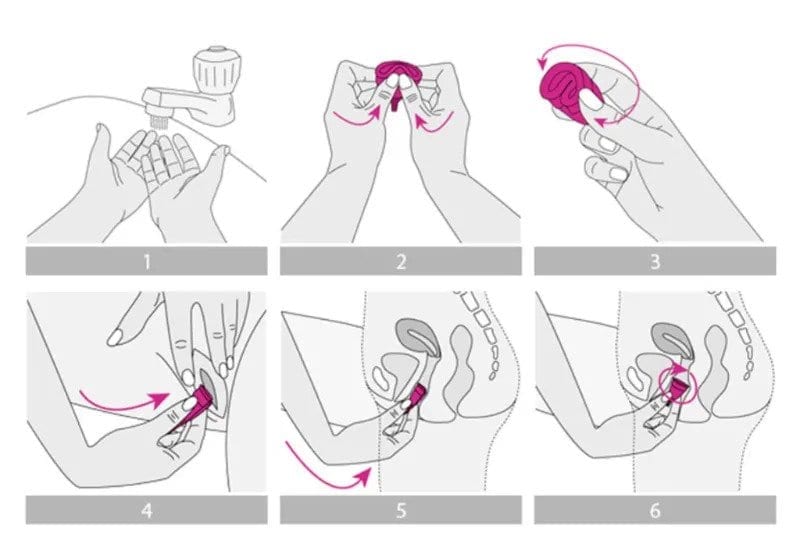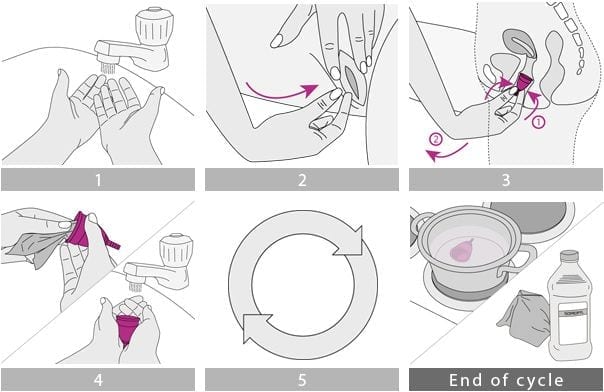Reusable menstrual products are becoming more and more popular and with good reason. Not only do they skip many of the health risks associated with disposable menstrual products but, because one reusable cup can last for years after a one-off payment of around £20, they’re better for both the environment and for your bank account.
Still, for many people who menstruate the idea of using a cup can be pretty daunting. (How do you insert and remove it? What about infections? Can it really fit all the way up there?) With that in mind here is our handy 101 guide, with help from Stephanie Taylor- the Managing Director of Kegel8, to help demystify this handy little product.
First things first- kill those germs
Your cup should be made from medical-grade silicone (don’t buy one that isn’t) which is naturally bacteria-resistant. However, you’ll still need to sterilise it both before use and in-between periods. You can do this either by boiling it in a small pan of water for 5-10 minutes, with the cup inside a whisk to make sure it doesn’t touch the pan, or with sterilising tablets. Either way, let it air-dry afterwards.
Oh and always wash your hands before and after handling it!
How to insert your menstrual cup…
The standard place to insert a cup is on or over the toilet, for… mess-related reasons. Not that you need to wait: Taylor recommends that ‘before your period comes, [you] practise inserting and removing’ it to build your confidence. After all, ‘you’re not going to be a pro straight away’. It’s also best to give yourself plenty of time and make sure you’re relaxed.
When you’re ready, start by folding the cup. The classic way is the c-fold- flatten the cup into a triangle and then fold it in half so that it looks like a letter C- but there are several other ways, which you can check out here and here.
Next, hold the cup tightly near the rim and gently insert it into your vagina up to the tip, before letting go so it opens up inside your body. Then rotate the cup both ways and/or gently pull it downwards a little, which will help it to fully open and form a seal. This will keep it in place and prevent most leaks – but keep some panty liners on standby, just in case.

… And how to remove it
Many cups can stay inside you for up to twelve hours but at some point you’ll need to remove and empty yours. Again, it’s important to relax. As Taylor explains, ‘The vaginal canal is full of muscles, so if you’re feeling tense your muscles may contract involuntarily, making removal far harder.’ With that in mind; ‘take deep breaths to steady and lower your heart rate. It’s ok to stop and try again later if you just can’t quite get it right the first time around.’
Once you’re ready, the first step is to ‘use [your] thumb and finger to softly squeeze the base of the cup (just above the stem) and release the seal. You can then wiggle the cup from side to side while gently pulling down.’ However, ‘try not to use your pelvic floor muscles to push the device out. This can be damaging to your vaginal health, even possibly resulting in prolapse.’ (Don’t panic, though as most users don’t encounter any problems.)

Once it’s out, empty it into the toilet and rinse it in the nearest sink. Taylor recommends ‘a special cleaning spray or mild soap and warm water’ but a thorough rinse with water is fine. Finally, if your cup has small air holes in the rim, follow the steps here to unblock them.
Reinsert the menstrual cup if necessary and you’re good to go!
If you haven’t bought your menstrual cup yet, take your time – there are many different options available!
Now all that’s left is for you to stay hydrated, get plenty of rest, and get a boost from the knowledge that you’re doing your bit both for you and for the planet.
Words by Emma Curzon with thanks to Stephanie Taylor from www.kegel8.co.uk.
Love Lifestyle? Read more here.
Support The Indiependent
We’re trying to raise £200 a month to help cover our operational costs. This includes our ‘Writer of the Month’ awards, where we recognise the amazing work produced by our contributor team. If you’ve enjoyed reading our site, we’d really appreciate it if you could donate to The Indiependent. Whether you can give £1 or £10, you’d be making a huge difference to our small team.
